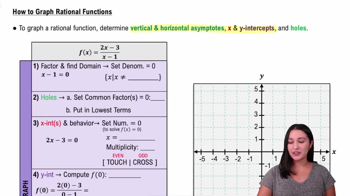Here are the essential concepts you must grasp in order to answer the question correctly.
Vertical Asymptotes
Vertical asymptotes occur in rational functions where the denominator equals zero, leading to undefined values. To find them, set the denominator of the function to zero and solve for the variable. The values obtained indicate the x-coordinates where the graph approaches infinity or negative infinity, creating vertical lines that the graph cannot cross.
Recommended video:
Determining Vertical Asymptotes
Horizontal and Slant Asymptotes
Horizontal asymptotes describe the behavior of a function as x approaches infinity or negative infinity. For rational functions, if the degree of the numerator is less than or equal to the degree of the denominator, a horizontal asymptote exists. Slant (or oblique) asymptotes occur when the degree of the numerator is exactly one more than that of the denominator, indicating that the graph will approach a linear function as x becomes very large or very small.
Recommended video:
Determining Horizontal Asymptotes
Graphing Rational Functions
Graphing rational functions involves plotting key features such as intercepts, asymptotes, and behavior at critical points. After identifying vertical and horizontal/slant asymptotes, one can determine the function's end behavior and sketch the graph accordingly. Additionally, finding x-intercepts and y-intercepts helps in accurately representing the function's overall shape and behavior.
Recommended video:
How to Graph Rational Functions
 Verified step by step guidance
Verified step by step guidance Verified video answer for a similar problem:
Verified video answer for a similar problem:



 5:31m
5:31m